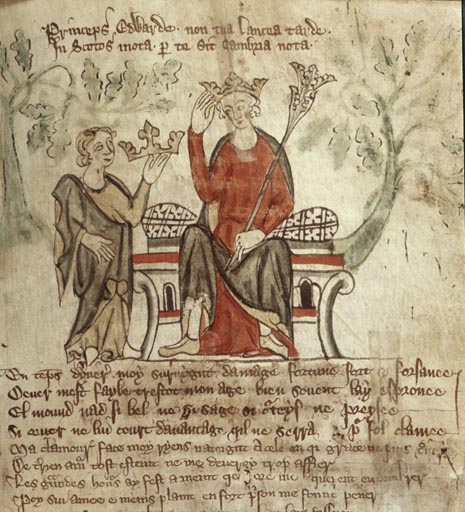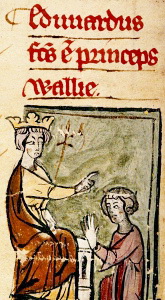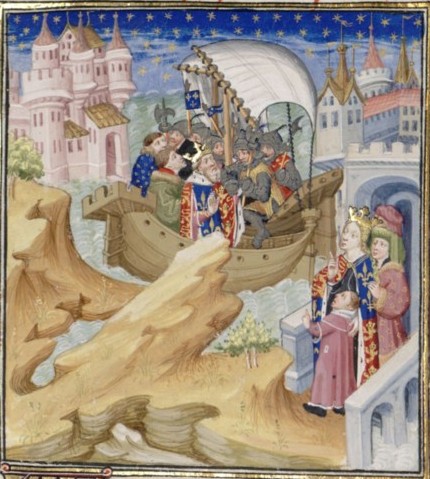by Susan Flantzer © Unofficial Royalty 2016

King Edward II of England; Credit – Wikipedia
King Edward II of England was born on April 25, 1284, at Caernarfon Castle in Gwynedd, Wales. Known as Edward of Caernarfon, he was the fourth son and the youngest of the 14-16 children of King Edward I of England and his first wife, Eleanor of Castile. Only six of their children survived childhood.
- Daughter (stillborn in May 1255)
- Katherine of England (before 1264 – 1264)
- Joan of England (born and died 1265)
- John of England (1266 – 1271)
- Henry of England (1268 – 1274)
- Eleanor of England (1269 – 1298), married Henri III, Count of Bar, had issue
- Daughter (born and died 1271)
- Joan of Acre (1272 – 1307), married (1) in 1290 Gilbert de Clare, 6th Earl of Hertford, had issue (2) in 1297 Ralph de Monthermer, 1st Baron Monthermer, had issue
- Alfonso, Earl of Chester (1273 – 1284)
- Margaret of England (1275 – after 1333), married John II, Duke of Brabant, had issue
- Berengaria (1276 – 1278)
- Daughter (born and died 1278)
- Mary of Woodstock (1279 – 1332), a Benedictine nun in Amesbury, Wiltshire
- Son (born in 1280 or 1281, who died very shortly after birth)
- Elizabeth of Rhuddlan (1282 – 1316), married (1) in 1297 John I, Count of Holland, no issue (2) in 1302 Humphrey de Bohun, 4th Earl of Hereford, 3rd Earl of Essex, had issue
Edward was born less than a year after his father, King Edward I, had taken complete control of Wales. At the time of his birth, Edward had only one surviving elder brother, Alphonso, Earl of Chester. However, ten-year-old Alphonso died four months after Edward’s birth, leaving his baby brother as heir to the throne. The tradition of conferring the title Prince of Wales on the heir apparent of the monarch is usually considered to have begun in 1301 when King Edward I of England invested his son Edward of Caernarfon with the title at a Parliament held in Lincoln. Since then, the title has been granted (with a few exceptions) to the heir apparent of the English or British monarch.

An early 14th-century depiction of Edward I (left) declaring his son Edward (right) the Prince of Wales; Credit – Wikipedia
In 1290, Edward’s mother, Eleanor of Castile, died at the age of 49. When Eleanor died, only six children, five daughters and one son, Edward, were still living. Edward was the youngest child and only six years old. King Edward I had to be worried about the succession, and a second marriage with sons would ensure the succession. On September 10, 1299, in Canterbury, England, 60-year-old King Edward I and 17-year-old Margaret of France were married. Edward also had three half-siblings from his father’s second marriage to Margaret of France:
- Thomas of Brotherton, 1st Earl of Norfolk (1300 – 1338), married (1) Alice de Hales, had issue (2) Mary de Brewes, no surviving issue
- Edmund of Woodstock, 1st Earl of Kent (1301 – 1330), married Margaret Wake, 3rd Baroness Wake of Liddell, had issue including Joan of Kent (The Fair Maid of Kent) who married King Edward III‘s eldest son Edward, Prince of Wales (The Black Prince) and was the mother of King Richard II of England
- Eleanor of England (1306 – 1311), died young
Because his father was often away on military campaigns and was accompanied by his mother, Edward had seen little of his parents and lacked parental guidance for most of his childhood. He had no living brothers, and four of his five surviving sisters (all older than him) were married, and the other sister was a nun. His half-siblings were not born until after he was 16 years old. Therefore, Edward did not grow up surrounded by siblings. Edward had an official household since he was an infant, and staff that took care of his personal needs and education.
Edward probably grew up as a lonely boy, longing for male companions of his own age, but his choices of favorites caused him many problems. His first favorite was Piers Gaveston from a family from Gascony (now in France). Gaveston had impressed King Edward I, and he was assigned to Edward of Caernarfon’s household and became Edward’s inseparable companion. Gaveston became involved in conflicts between King Edward I and his son. The situation got so bad that shortly before his death, King Edward I banished Gaveston.

Isabella of France; Credit – Wikipedia
King Edward I died on a military campaign on July 7, 1307. As a child, Edward was betrothed to Isabella of France, daughter of King Philippe IV of France and Joan I, Queen of Navarre in her own right. The marriage was arranged to resolve the conflicts between France and England over England’s possession of Gascony and claims to Anjou, Normandy, and Aquitaine. However, King Edward I attempted to break the betrothal several times, and the marriage did not occur until after his death. Isabella and King Edward II were married on January 25, 1308, at Boulogne Cathedral in France. The couple’s coronation was held at Westminster Abbey on February 25, 1308. Isabella and Edward had four children.
- King Edward III of England (1312 – 1377), married Philippa of Hainault, had issue
- John of Eltham, 1st Earl of Cornwall (1316 – 1336), unmarried
- Eleanor of Woodstock (1318 – 1355), married Reinoud II of Guelders, had issue
- Joan of the Tower (1321 – 1362), married King David II of Scotland, no issue
One of King Edward II’s first acts as king was to recall to court his favorite Piers Gaveston. From the start of her marriage, Isabella was confronted with the close relationship between her husband and Gaveston, described as “an arrogant, ostentatious soldier, with a reckless and headstrong personality.” The true nature of their relationship is not known, and there is no contemporary evidence that comments directly on Edward’s sexual orientation. Gaveston was created Earl of Cornwall, a title usually given to the sons of the king, and Edward arranged for Gaveston to marry his niece Margaret de Clare, which greatly displeased the English nobility.
Eventually, with the influence of Isabella’s father, Dowager Queen Margaret, who was Isabella’s aunt, and the Archbishop of Canterbury, Edward agreed to exile Gaveston to Ireland. However, in a move that angered the barons, Edward made Gaveston Regent of Ireland. When Gaveston returned to England in 1312, he was hunted down and executed by a group of barons led by Edward’s uncle, Thomas, 2nd Earl of Lancaster, and Guy de Beauchamp, 10th Earl of Warwick.

Depiction of the Battle of Bannockburn in 1314 from the Holkham Bible; Credit – Wikipedia
In 1314, King Edward II took up arms in an attempt to complete his father’s campaign in Scotland, resulting in a decisive Scottish victory at the Battle of Bannockburn by a smaller army led by Robert the Bruce, King of Scots.
From 1312 – 1321, there is no evidence that Edward and Isabella had a discordant marriage or that Isabella was not loyal to her husband. Isabella took a role in the reconciliation between Edward and the barons, who were responsible for the execution of Gaveston. However, during this period, Hugh Despenser the Elder became part of Edward’s inner circle, marking the beginning of the Despensers’ increased prominence at Edward’s court. His son, Hugh Despenser the Younger, became a favorite of Edward II. Edward was willing to let the Despensers do as they pleased, and they grew rich from their administration and corruption.
It is thought that Edward’s wife Isabella first met and fell in love with Roger Mortimer, 1st Earl of March when he was a prisoner in the Tower of London, both a royal palace and a prison at that time. Isabella arranged for Mortimer’s death sentence to be commuted to life imprisonment. In 1323, Isabella helped arrange Mortimer’s escape from the Tower and his subsequent flight to France. During the next year, Isabella had had enough of the Despensers and left Edward, who made an unwise decision to send Isabella and their 12-year-old son Edward on a mission to France. Not surprisingly, Isabella met Mortimer in France, where they planned to depose Edward II. Isabella gathered an army and set sail for England, landing at Harwich on September 25, 1326. With their mercenary army, Isabella and Mortimer quickly seized power. The Despensers were both executed, and Edward II was forced to abdicate. Isabella’s son was crowned King Edward III, and Isabella and Mortimer served as regents for the teenage king.

A 15th-century depiction of Isabella capturing Edward II; Credit – Wikipedia
King Edward II was sent to Berkeley Castle, where castle records indicate he was well treated. The circumstances of what happened to him are uncertain. One theory is that he died at Berkeley Castle on September 21, 1327, murdered on the orders of Isabella and Mortimer. His body was then embalmed at Berkeley Castle, was shown to local town leaders, and was buried at St. Peter’s Abbey in Gloucester. The abbey was dissolved in 1540 by King Henry VIII and became Gloucester Cathedral in 1541. Certainly, King Edward III arranged for a tomb for his father to be constructed with an alabaster effigy, a tomb chest, and a canopy made of oolite and Purbeck stone. King Edward II’s tomb, restored in 2007-2008, can still be seen in Gloucester Cathedral. However, there are other theories about his death, including one that says he did not die in 1327 but escaped Berkeley Castle with the help of a servant.

Tomb of King Edward II; Photo Credit – Wikipedia

Effigy of King Edward II; By Philip Halling http://www.geograph.org.uk/profile/1837 – http://www.geograph.org.uk/photo/2133715, CC BY-SA 2.0, https://commons.wikimedia.org/w/index.php?curid=31221892
In 1330, the 18-year-old King Edward III conducted a coup d’état at Nottingham Castle, where Mortimer and Isabella were staying. Mortimer was arrested and executed on fourteen charges of treason, including the murder of Edward II. After the coup, Isabella was taken to Berkhamsted Castle and then held under house arrest at Windsor Castle. In 1332, Isabella was moved to her own Castle Rising in Norfolk, where she was confined for the rest of her life, enjoying a regal lifestyle, until her death at the age of 63 in 1358.
This article is the intellectual property of Unofficial Royalty and is NOT TO BE COPIED, EDITED, OR POSTED IN ANY FORM ON ANOTHER WEBSITE under any circumstances. It is permissible to use a link that directs to Unofficial Royalty.
England: House of Plantagenet Resources at Unofficial Royalty
- United Kingdom of Great Britain and Northern Ireland Index
- House of Plantagenet Index (1216 – 1399)
- British Royal Births, Marriages, Deaths, and Other Important Events
- Coronations after the Norman Conquest (1066 – present)
- History and Traditions: Norman and Plantagenet Weddings
- House of Plantagenet Burial Sites
